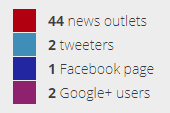BioTechniques publications: reviewing 2018 and previewing 2019

Managing Editor of BioTechniques, Joseph Martin, looks back at the most popular peer-reviewed content of 2018, as well as providing insight on what’s to come for authors in 2019.
2018 in peer-reviewed content
The most downloaded BioTechniques article of 2018 was entitled “Automating a new host-protein assay for differentiating bacterial from viral infection to reduce operator hands-on time.” This benchmark describes a novel in vitro diagnostic assay that distinguishes bacterial from viral infections based on the patient immune response, enabling higher analytical performance and shorter technician hands-on time, both critical parameters when triaging febrile patients in urgent care settings. Amazingly this article has been downloaded over 16,000 times since its publication in August last year.
With over 2000 downloads, another popular article from 2018 saw researchers based at Christian-Albrechts-Universität zu Kiel (Kiel, Germany) benchmark two new commercial urine cell-free DNA isolation kits. Published in May, the article entitled “Quantifying cell free DNA in urine: comparison between commercial kits, impact of gender and inter-individual variation” also received attention from four news outlets.
Similarly, with over 2000 downloads, the report entitled “A probe directed recombinase amplification assay for detection of MTHFR A1298C polymorphism associated with congenital heart disease” has been well-received since its publication in May. The authors propose a novel PDRA assay as a valuable tool for the detection of SNPs and demonstrate significant potential to be widely applicable in both research and clinical settings. Interestingly, to our knowledge, the proposed method is the first report to detect SNPs using one probe and one primer.
Continuing to improve the reproducibility of protocols
At BioTechniques, we encourage all authors to submit a detailed protocol alongside any new method or technique published in the journal. It is becoming increasingly important to ensure that these protocols are easily reusable to help increase the overall reproducibility of a method by providing users with detailed instructions for performing their experiments. With this in mind, BioTechniques has recently partnered with Profeza, a product aimed at improving the reproducibility of research methods.
Another popular article published in November utilizes this new product. Tang et al. presents TEG-seq, a target-enriched GUIDE-seq using an ion-torrent next-generation sequencing platform for unbiased genome-wide CRISPR off-target detection. The new protocol reduces nonspecific amplification, and therefore increases its sensitivity for off-target detection. If reusing this protocol, please do report your reuse at Profeza by adding your own comments, recommendations and suggestions.
Moving with the times
With the ever-increasing impact of social media, it is important to measure the influence of our publications through more than just the number of downloads. Altmetrics is a powerful way to measure this. It collates information from multiple different sources across different platforms to show the way in which research is being broadcast across the world.
Altmetrics features a useful graphic to visualize the ‘Altmetric Attention Score’ for a research output. The score is derived from an automated algorithm and represents a weighted count of the amount of attention received for a research output.


The most prominent example of this from 2018 was the review entitled “Overlooked benefits of using polyclonal antibodies”. With an attention score of 352, as shown in the figure above, it is clear that this article has reached many readers via several platforms, including 44 news outlets, 2 tweets, 1 facebook page, 2 google+ user and 9 readers on Mendeley. Interestingly this article highlights the best practices for developing and using polyclonal antibodies, pitfalls to their use and how to avoid them, in addition to benefits to the life science community.
I would like to thank our readers, contributing authors, valued Editorial Board members and peer-reviewers for their continued support and collaboration as we continue to publish the latest cutting-edge research. I very much look forward to working with you all over the next year and hope to see BioTechniques continue to grow and serve the research community in 2019.
I now also look forward to the continuing growth of the BioTechniques online community in 2019, with a brand new website for news and online-only features and the introduction of more online-only features.
To submit your manuscript to BioTechniques, or if you have any questions regarding Profeza or the peer-reviewed content, please contact me on [email protected].




